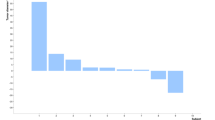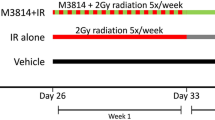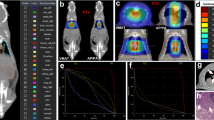Abstract
TNFerade Biologic (TNFerade) is a second-generation (E1-, E3-, and E4-deleted) replication-deficient adenovector carrying the transgene encoding for human tumor necrosis factor alpha (TNFα), regulated by the radiation-sensitive promoter Early Growth Response (Egr-1). We hypothesized that intratumoral injection of TNFerade followed by radiation would result in potentially therapeutic levels of TNFα with minimal toxicity. Three preclinical studies were conducted, the purpose of which was to characterize the toxicity and pharmacokinetics of TNFerade in conjunction with radiation in nude as well as immune-competent (Balb/c) mice. A total of 80 mice in the nude mouse toxicology study, all bearing human squamous cell carcinoma xenografts, 120 mice in the Balb/c study, and 33 nude mice in the pharmacokinetic study were used. Doses ranging from 4×109 to 4×1010 particle units (pu) (4×1011 pu in the Balb/c study) were explored, with and without radiation. In the nude mice studies, TNFerade was injected intratumorally, whereas in the Balb/c study, TNFerade was administered by subcutaneous injection. TNFerade was well tolerated. In the nude mice studies, no significant toxicity occurred in any dose group. In the Balb/c study, 6/40 mice at the top dose (4×1011 pu) were sacrificed in moribund condition (5/20 in the TNFerade+radiation group, 1/20 in the TNFerade alone group). Necropsy showed local necrosis and ulceration at the site of the injection. No deaths or significant toxicity were observed at the lower dose levels (4×109 and 4×1010 pu), indicating a large safety margin for initial studies in humans. The pharmacokinetic study demonstrated high sustained levels of TNFα in the tumor homogenate with no “spillover” to plasma, where TNFα levels were below the level of detection. Radiation increased intratumoral levels of TNFα by a factor of 12 (from 0.998 to 11.55 ng/g). In conclusion, a gene therapy approach with TNFerade, in combination with radiation, represents a potential way to utilize the potent anticancer activity of TNFα without systemic toxicity.
This is a preview of subscription content, access via your institution
Access options
Subscribe to this journal
Receive 12 print issues and online access
$259.00 per year
only $21.58 per issue
Buy this article
- Purchase on Springer Link
- Instant access to full article PDF
Prices may be subject to local taxes which are calculated during checkout
Similar content being viewed by others
References
Balkwell FR, Lee A, Aldam G et al. Human tumor xenografts treated with recombinant human tumor necrosis factor alone or in combination with interferon Cancer Res 1996 46: 3990–3993
Asher A, Mule JJ, Reichert CM et al. Studies on the anti-tumor efficacy of systemically administered recombinant tumor necrosis factor against several murine tumors in vivo J Immunol 1987 138: 963–974
Renard N, Lienard D, Lespagnard L et al. Early endothelium activation and polymorphonuclear cell invasion precede specific necrosis of human melanoma and sarcoma treated by intravascular high-dose tumor necrosis factor alpha (rTNA alpha) Int J Cancer 1994 57: 656–663
Fukumura D, Salehi HA, Witwer B et al. Tumor necrosis factor alpha–induced leukocyte adhesion in normal and tumor vessels: effect of tumor type, transplantation site, and host strain Cancer Res 1995 55: 4824–4829
Hallahan DE, Vokes EE, Rubin SJ et al. Phase I dose-escalation study of tumor necrosis factor-alpha and concomitant radiation therapy Cancer J Sci Am 1995 1: 204–209
Chapman PB, Lester TJ, Casper ES et al. Clinical pharmacology of human tumor necrosis factor in patients with advanced cancer J Clin Oncol 1987 5: 1942–1951
Feinberg B, Kurzrock R, Talpaz M et al. A phase I trial of intravenously administered recombinant tumor necrosis factor-alpha in cancer patients J Clin Oncol 1988 6: 1328–1334
Springs DR, Sherman ML, Michie H et al. Recombinant tumor necrosis factor administered as a 24-hour intravenous infusion. A phase I and pharmacologic study J Natl Cancer Inst 1988 80: 1039–1044
Lienard D, Ewalenko P, Delmotte JJ et al. High-dose recombinant tumor necrosis factor alpha in combination with interferon gamma and melphalan in isolation perfusion of the limbs for melanoma and sarcoma J Clin Oncol 1992 10: 52–60
Thom AK, Alexander HR, Andrich MP et al. Cytokine levels and systemic toxicity in patients undergoing isolated limb perfusion with high-dose tumor necrosis factor, interferon gamma, and melphalan J Clin Oncol 1995 13: 264–273
Seung LP, Mauceri HJ, Beckett MA et al. Genetic radiotherapy overcomes tumor resistance to cytotoxic agents Cancer Res 1995 55: 5561–5565
Chung T, Mauceri HJ, Hallahan DE et al. Tumor necrosis factor-α–based gene therapy enhances radiation cytotoxicity in human prostate cancer Cancer Gene Ther 1998 5: 344–349
Staba MJ, Mauceru HJ, Kufe DW et al. Adenoviral TNFα gene therapy and radiation damage tumor vasculature in a human malignant glioma xenograft Gene Ther 1988 5: 293–300
Gupta VK, Park JO, Jaskowiak NT et al. Combined gene therapy and ionizing radiation is a novel treatment for human esophageal cancer J Surg Oncol 2002 (in press)
Brough DE, Lizonova A, Hsu C et al. A gene transfer vector-cell line system for complete functional complementation of adenovirus early regions E1 and E4 J Virol 1996 70: 6497–6501
Marr RA, Addison CC, Snider D et al. Tumour immunotherapy using an adenoviral vector expressing a membrane-bound mutant of murine TNF alpha Gene Ther 1997 4: 1181–1188
Marr RA, Hitt M, Muller WJ et al. Tumour therapy in mice using adenovirus vectors expressing human TNFα Int J Oncol 1998 12: 509–515
Marr RA, Hitt M, Gauldie J et al. A p75 tumor necrosis factor receptor–specific mutant of murine tumor necrosis factor alpha expressed from an adenovirus vector induces an antitumor response with reduced toxicity Cancer Gene Ther 1999 6: 465–474
Wright P, Braun R, Babiuk L et al. Adenovirus-based TNF-alpha gene transfer induces significant tumor regression in mice Cancer Biother Radiopharm 1999 14: 49–57
Hallahan DE, Beckett MA, Kufe D et al. The interaction between human recombinant tumor necrosis factor and radiation in 13 human tumor cell lines Int J Radiat Oncol Biol Phys 1990 19: 69–74
Sersa AG, Willingham V, Milas L . Antitumor effects of tumor necrosis factor alone or combined with radiotherapy Int J Cancer 1988 42: 129–134
Wong GH, McHugh T, Weber R et al. Tumor necrosis factor selectively sensitizes human immunodeficiency virus-infected cells to heat and radiation Proc Natl Acad Sci USA 1991 88: 4372–4376
Hidaka C, Milano E, Leopold PL et al. CAR-dependent and CAR-independent pathways of adenovirus vector–mediated gene transfer and expression in human fibroblast J Clin Invest 1999 4: 579–587
McDonald D, Stockwin L, Matzow T et al. Coxsackie and adenovirus receptor (CAR)–dependent and major histocompatibility complex (MHC) class I–independent upstage of recombinant adenoviruses into human tumour cells Gene Ther 1999 9: 1512–1519
Creaven PJ, Plager JE, Dupere S . Phase I trial of recombinant human tumour necrosis factor Cancer Chemother Pharmacol 1997 20: 137–144
Talmadge JE, Kaushansky K, Seal GM et al. Immunomodulatory properties of recombinant murine and human tumor necrosis factor Cancer Res 1988 48: 544–550
Carswell EA, Old LJ, Kassel RL et al. An endotoxin-induced serum factor that causes necrosis of tumors Proc Natl Acad Sci USA 1975 72: 3666–3670
Larick JW, Wright SC . Cytotoxic mechanisms of tumor necrosis factor-alpha FASEB J 1994 4: 3215–3223
Fiers W . Tumor necrosis factor: characterization at the molecular, cellular, and in vivo level FEBS Lett 1991 285: 199–212
Sarraf CE . Tumor necrosis factor and cell death in tumors Int J Oncol 1994 5: 1333–1339
Benigni F, Faggioni R, Sironi M et al. TNF receptor p55 plays a major role in centrally mediated increases of serum IL-6 and corticosterone after intracerebroventricular injection of TNF J Immunol 1996 157: 5563–5568
Vandenabeele P, Declerq W, Vercammen D et al. Functional characterization of the human tumor necrosis factor receptor p75 in a transfected rat/mouse T cell hybridoma J Exp Med 1992 176: 1015–1024
Lewis M, Tartaglia LA, Bennett LA et al. Cloning and expression of a cDNA for two distinct murine tumor necrosis factor receptors demonstrates one receptor is species specific Proc Natl Acad Sci USA 1991 88: 2830–2834
Erickson SL, de Sauvage FJ, Kikly K et al. Decreased sensitivity to tumor-necrosis factor but normal T-cell development in TNF receptor-2–deficient mice Nature 1994 372: 560–563
Acknowledgements
We thank Angela Barber for her competent and knowledgeable assistance in the preparation of this manuscript.
Author information
Authors and Affiliations
Corresponding author
Rights and permissions
About this article
Cite this article
Rasmussen, H., Rasmussen, C., Lempicki, M. et al. TNFerade Biologic: Preclinical toxicology of a novel adenovector with a radiation-inducible promoter, carrying the human tumor necrosis factor alpha gene. Cancer Gene Ther 9, 951–957 (2002). https://doi.org/10.1038/sj.cgt.7700518
Received:
Published:
Issue Date:
DOI: https://doi.org/10.1038/sj.cgt.7700518
Keywords
This article is cited by
-
Comparison of systemic and mucosal vaccination: impact on intravenous and rectal SIV challenge
Mucosal Immunology (2012)
-
The role of radiotherapy in locally advanced pancreatic carcinoma
Nature Reviews Gastroenterology & Hepatology (2010)
-
Combination of human tumor necrosis factor-alpha (hTNF-α) gene delivery with gemcitabine is effective in models of pancreatic cancer
Cancer Gene Therapy (2009)
-
Chimeric form of tumor necrosis factor-α has enhanced surface expression and antitumor activity
Cancer Gene Therapy (2009)
-
Resveratrol is an effective inducer of CArG-driven TNF-α gene therapy
Cancer Gene Therapy (2008)



